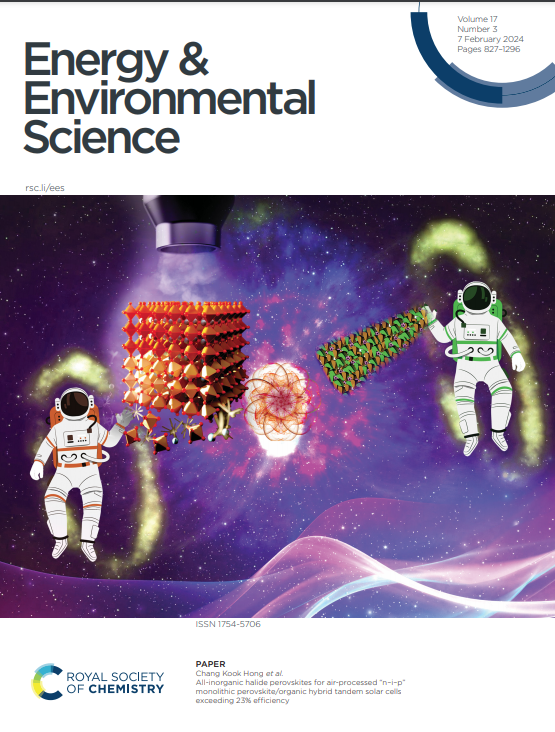Zn2+-blocking effects of a proton-rich polyaniline layer enable Ah-level Zn–MnO2 batteries
IF 32.4
1区 材料科学
Q1 CHEMISTRY, MULTIDISCIPLINARY
引用次数: 0
Abstract
Low-cost and high-theoretical capacity manganese dioxide (MnO2) has garnered great attention in developing aqueous Zn–MnO2 batteries (AZMBs). However, achieving high-capacity and long-cycle-life AZMBs remains challenging owing to “dead” MnO2 formation and irreversible Zn2+ insertion. Herein, we introduced polyaniline (PANI) to provide a proton-rich micro-environment for organic modified MnO2 (denoted as P-MnO2) as an effective cathode with carbon nanotubes as conductive networks. The P-MnO2 cathode exhibits a remarkable capacity of 510 mAh g−1 at 0.2 A g−1 and a capacity retention of 87% over 14 000 cycles at 5 A g−1. Even under a high loading of 23.5 mg cm−2, the as-constructed Zn//P-MnO2 pouch cell demonstrates a capacity of 275 mAh after 110 cycles at 0.73 mA cm−2. Its maximum capacity could even reach up to 1.5 Ah at 0.15 mA cm−2, with a coulombic efficiency of 99.1%. Elemental mapping reveals that proton conductive PANI acts as a “Zn2+ filter”, selectively blocking Zn2+ insertion while facilitating proton transport, thereby preventing irreversible ZnMn2O4 generation and stimulating deposited MnO2 reuse. Combined in/ex situ characterizations and theoretical calculations confirm the formation of interfacial Mn–N bonds and their functions to improve the structural robustness of the P-MnO2 cathode, demonstrating the great potential of organic–inorganic interface engineering for advanced AZMBs.

富质子聚苯胺层对Zn2+的阻断作用使ah级Zn-MnO2电池成为可能
低成本、高理论容量的二氧化锰(MnO2)在锌-二氧化锰水溶液电池(AZMBs)的开发中受到了广泛关注。然而,由于“死”MnO2的形成和不可逆的Zn2+插入,实现高容量和长循环寿命的azmb仍然具有挑战性。在此,我们引入聚苯胺(PANI)为有机改性MnO2(表示为P-MnO2)提供了一个富含质子的微环境,作为碳纳米管作为导电网络的有效阴极。P-MnO2阴极在0.2 a g−1下的容量为510 mAh g−1,在5 a g−1下的14000次循环中容量保持率为87%。即使在23.5 mg cm−2的高负载下,构建的Zn//P-MnO2袋电池在0.73 mA cm−2下循环110次后也显示出275 mAh的容量。在0.15 mA cm−2下,其最大容量甚至可以达到1.5 Ah,库仑效率为99.1%。元素图谱显示,质子导电聚苯胺作为“Zn2+过滤器”,选择性地阻断Zn2+的插入,同时促进质子的传输,从而防止不可逆的ZnMn2O4的生成,并刺激沉积的MnO2的再利用。结合原位/非原位表征和理论计算证实了界面Mn-N键的形成及其提高P-MnO2阴极结构稳健性的功能,显示了先进AZMBs有机-无机界面工程的巨大潜力。
本文章由计算机程序翻译,如有差异,请以英文原文为准。
求助全文
约1分钟内获得全文
求助全文
来源期刊

Energy & Environmental Science
化学-工程:化工
CiteScore
50.50
自引率
2.20%
发文量
349
审稿时长
2.2 months
期刊介绍:
Energy & Environmental Science, a peer-reviewed scientific journal, publishes original research and review articles covering interdisciplinary topics in the (bio)chemical and (bio)physical sciences, as well as chemical engineering disciplines. Published monthly by the Royal Society of Chemistry (RSC), a not-for-profit publisher, Energy & Environmental Science is recognized as a leading journal. It boasts an impressive impact factor of 8.500 as of 2009, ranking 8th among 140 journals in the category "Chemistry, Multidisciplinary," second among 71 journals in "Energy & Fuels," second among 128 journals in "Engineering, Chemical," and first among 181 scientific journals in "Environmental Sciences."
Energy & Environmental Science publishes various types of articles, including Research Papers (original scientific work), Review Articles, Perspectives, and Minireviews (feature review-type articles of broad interest), Communications (original scientific work of an urgent nature), Opinions (personal, often speculative viewpoints or hypotheses on current topics), and Analysis Articles (in-depth examination of energy-related issues).
 求助内容:
求助内容: 应助结果提醒方式:
应助结果提醒方式:


